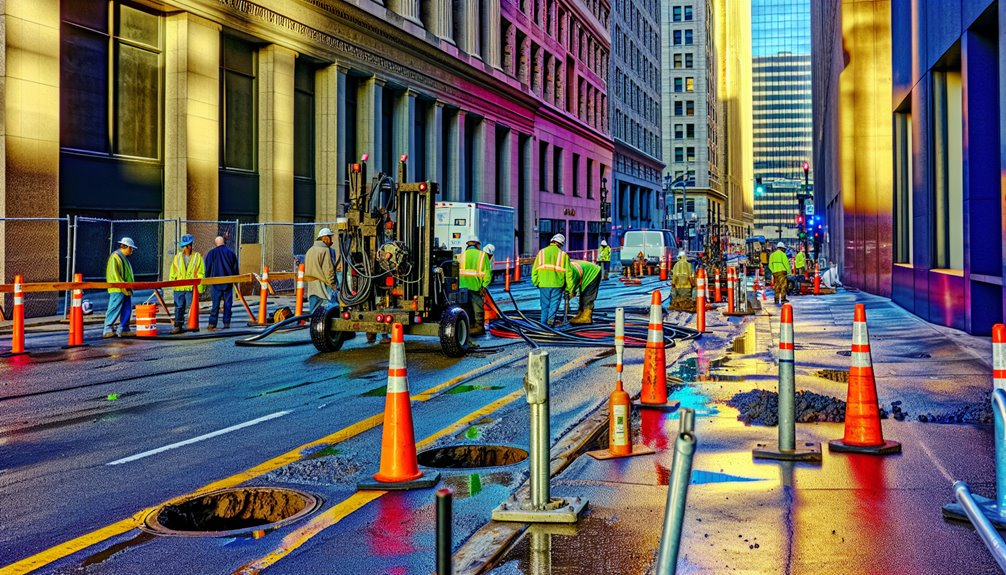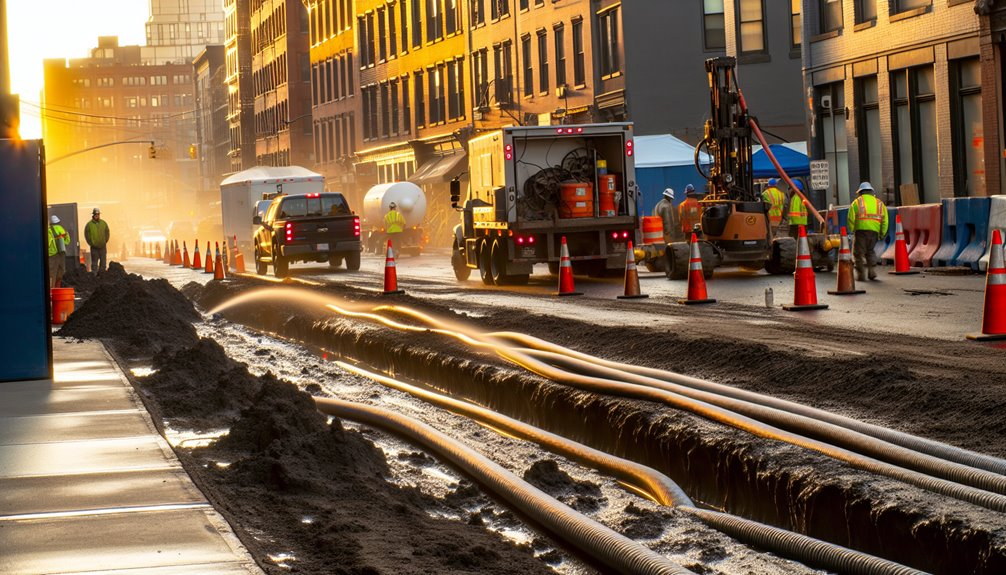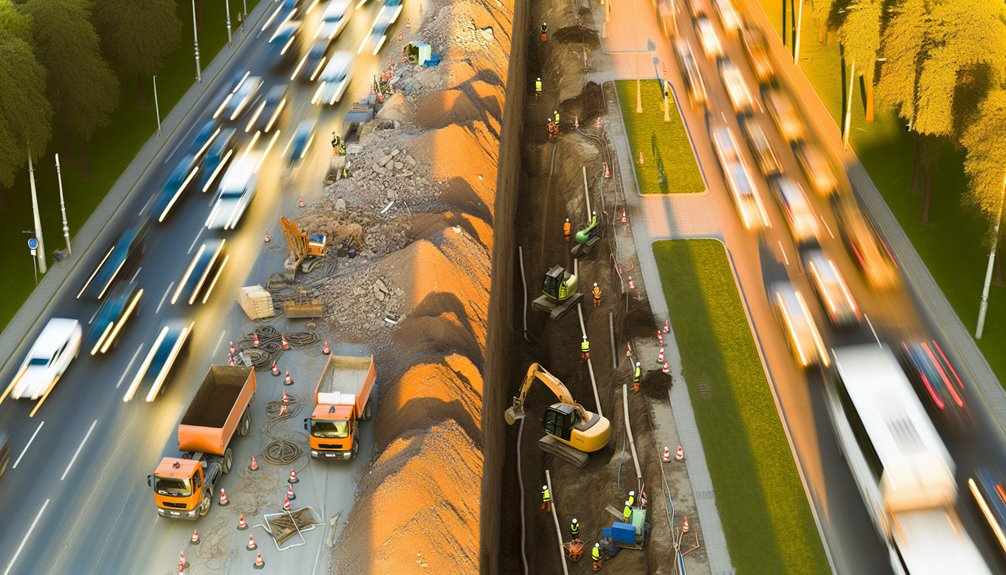You’ll reduce risk on trenchless borings by validating utility data early, coordinating owners for mark-outs and standby, and tying permits and traffic control to milestones. Use risk-based geotech to choose HDD vs microtunneling, set steering/pressure QA thresholds, and bundle crossings to limit mobilizations. Build contingencies into schedule and costs, prioritize scope, and tie payments to performance. Archive surveys, permits, and as-builts for claims and improvement. Next, align stakeholders with a concise communication plan.
Map Existing Utilities and Validate As-Builts Early

Before you put a drill head in the ground, verify what’s already there. Start with utility verification that combines desktop and field methods. Pull current GIS layers, as-builts, and one-call tickets, then perform electromagnetic locating, GPR, and daylighting at conflict points. Document depths, materials, and offsets with survey-grade accuracy.
Conduct record reconciliation by comparing found conditions to plan sheets; flag mismatches, update coordinates, and note abandoned or undocumented lines. Calibrate your bore path to agreed vertical and horizontal clearances per local and PHMSA/OSHA guidance.
Create a controlled utility register with chain-of-custody for data edits. Archive photos, pothole logs, and locator screenshots. You’ll reduce strikes, change orders, and schedule risk while giving the whole team defensible, shared facts for design and permitting.
Align Stakeholders With a Clear Communication Plan
With verified utility data in hand, set up a communication plan that specifies who needs what information, when, and through which channel.
Identify regulators, utility owners, emergency services, adjacent businesses, residents, and your construction team.
Define decision rights, escalation paths, and response times.
Map notifications to milestones: preconstruction outreach, mobilization, night work, traffic shifts, and restoration.
Use stakeholder workshops to synchronize constraints, permit conditions, and outage windows.
Publish construction timelines and contact points via community newsletters, SMS alerts, a project webpage, and 24/7 hotline.
Standardize message templates for service impacts, access changes, and noise windows.
Track commitments in a register and report progress weekly.
Translate materials as needed and assure ADA-accessible formats.
Document all interactions to meet public records and permit requirements.
Choose the Right Trenchless Method for Urban Constraints

Although multiple trenchless options can fit a corridor, you should match method to constraints using quantified criteria: geotechnical profile, allowable settlement, bore length and curvature, diameter, utility congestion, vibration/noise limits, groundwater pressures, launch/exit footprint, and schedule.
Evaluate microtunneling feasibility where face support and tight grade control are mandatory; confirm jacking forces, slurry treatment capacity, and shaft clearances.
For HDD alignment, verify bend radii, drill fluid returns, and strike risk near dense utilities.
Calibrate risk by modeling predicted settlement and noise/vibration against urban thresholds.
Choose equipment that fits your staging envelope and keeps neighbors safe and connected.
- Validate soil data with lab tests and CPTs.
- Limit curvature to tool capabilities.
- Quantify annular pressure.
- Right-size separation plants.
- Define acceptance tolerances.
Coordinate Permitting and Right-of-Way Approvals
Your method selection sets the engineering basis; now you need permits and access that reflect those constraints.
Build a permit sequencing plan that maps each approval to design milestones: utility consents, traffic control, noise variances, environmental clearances, and railroad or transit approvals. Identify the decision critical path and float; file early where third-party reviews are slow.
Coordinate right-of-way by aligning easement negotiation with alignment sheets and staging needs. Define bore pit footprints, laydown areas, and temporary access routes in exhibits. Verify title, encumbrances, and municipal franchise authority; secure signatures and notary requirements before bid.
Establish a single point of contact for agencies to reduce conflicting conditions. Track conditions of approval in a matrix and flow them into contract documents, schedules, and public notifications.
Assess Ground Conditions and Manage Geotechnical Risk

Before steel goes in the ground, characterize the subsurface to a level that matches trenchless risk: plan a phased geotechnical program tied to alignment sheets, bore pit locations, and method selection. You’ll reduce uncertainty, comply with specifications, and set your team up to succeed under urban constraints. Use soil sampling, groundwater monitoring, and lab testing to define stratigraphy, strengths, abrasivity, and corrosivity that dictate tooling, thrust, and slurry design.
- Map variability: advance borings and CPTs at risk-based spacing along the alignment.
- Quantify groundwater: install piezometers, perform pumping tests, and model inflow.
- Prove constructability: run Direct Shear, UCS, Atterberg, and permeability tests.
- Control settlements: develop face-pressure, annulus grouting, and volume-balance targets.
- Manage change: update baselines, contingencies, and instrumentation plans as data arrives.
Mitigate Utility Conflicts With Targeted Potholing
Armed with a geotechnical model, you still need to prove where existing utilities actually sit in three dimensions. Use targeted potholing to convert assumed locates into surveyed truth. Prioritize crossings with minimal clearances, abandoned lines, and high-consequence assets. Sequence test holes ahead of design finalization so horizontal and vertical alignments can shift before procurement. Specify vacuum excavation, utility verification by licensed survey, and utility quality level upgrades per ASCE 38/CI/ASCE 75. Record pipe material, diameter, depth to crown/invert, bedding, and encasements.
Map results into your BIM/GIS, tie to control, and update risk registers. Coordinate with utility owners for standby and mark-out reconciliation; issue conflict matrices with disposition (adjust alignment, sleeve, or isolate). Archive photo logs, station/offset data, and permits to maintain defensible records and team trust.
Optimize Traffic Control and Work Zone Safety

Often the success of trenchless work in dense corridors hinges on a scalable traffic control plan that meets MUTCD, OSHA, and local agency requirements while minimizing network delay. You’ll protect crews and neighbors by aligning detours, lane closures, and access needs with peak-hour restrictions and emergency response routes. Specify devices, spacings, and tapers using MUTCD tables, and verify sight distances. Elevate worker visibility with Class 3 garments, lighting levels, and cone retroreflectivity that match posted speeds.
- Coordinate police details and flaggers with clear radio protocols and backup staffing.
- Use smart arrow boards and Bluetooth sensors to adapt queues in real time.
- Stage deliveries off-peak; maintain ADA paths and transit stops.
- Separate equipment swing radii with positive protection.
- Document pre-shift briefings, near-miss logs, and corrective actions.
Build a Resilient Schedule With Contingencies
Even when the geotechnical report looks clean, you should harden the schedule with defined float, decision gates, and preapproved workarounds tied to trigger points. Build phased milestones that lock in permit lead times, utility locates, and submittal reviews, so field crews and inspectors move together.
Map risk registers to each phase, assign owners, and set “go/no-go” checks before launching the bore. Integrate contingency funding with time contingencies: allocate recovery windows for cutterhead changes, slurry treatment adjustments, or unexpected obstructions, and document how to activate them.
Coordinate night-work windows, noise curfews, and haul routes with agency calendars to avoid violations. Embed supplier alternates and standby crews in contracts. Maintain daily variance tracking; if progress drifts beyond thresholds, escalate to the decision gate and execute the predefined workaround.
Control Costs With Scope Prioritization and Value Engineering

Start by ranking scope elements against functional need, regulatory minimums, and lifecycle cost so you only pay for what delivers performance and compliance.
Strip noncritical features, but preserve safety factors, corrosion protection, and restoration standards.
Use value engineering to compare trenchless methods, shaft layouts, and pipe materials against geotechnical risk and hydraulic performance.
Align bid packages with phased procurement to capture market pricing and reduce cash-flow exposure.
Tie contractor payment to measurable output with performance incentives that prioritize accuracy, settlement control, and utility conflict avoidance.
Keep the team aligned on what matters and you’ll protect rates and trust.
- Define must-haves vs. nice-to-haves.
- Right-size diameters, depths, and liner classes.
- Standardize details to cut custom fabrication.
- Bundle similar crossings to reduce mobilizations.
- Stage work to leverage phased procurement and incentives.
Monitor Performance and Document Lessons Learned
While production advances beneath busy streets, you should instrument, verify, and record performance against defined baselines so deviations trigger timely corrections and defensible documentation. Calibrate guidance systems, track thrust, torque, annular pressure, and advance rate, and compare to geotechnical forecasts. Flag variance thresholds in your QA plan and implement hold points for steering, lubrication, and spoil returns. Log near‑misses, utility strikes, settlement readings, and corrective actions with timestamps to satisfy permit conditions and claims scrutiny.
Conduct daily stand‑ups to interpret data and assign countermeasures. After completion, run post‑project audits that reconcile as‑builts, productivity curves, and cost codes with risk registers. Curate findings in searchable knowledge repositories, tagging by soil unit, diameter, and method. Share across departments so your team standardizes improvements and reduces future uncertainty.
Conclusion
As the owner of Boring Bros., I’ve learned that successful trenchless work in cities comes down to planning, teamwork, and staying flexible — map utilities early, validate as-builts with potholing, pick HDD or microtunneling based on geotech risk, set QA limits, bundle crossings, and tie payments to performance while protecting your schedule and permits. If you’d like to talk about a project or learn more about how we approach urban boring, visit boringbro.com or give us a call at (954) 639-6167 — I’d love to hear from you and help find the right solution.




